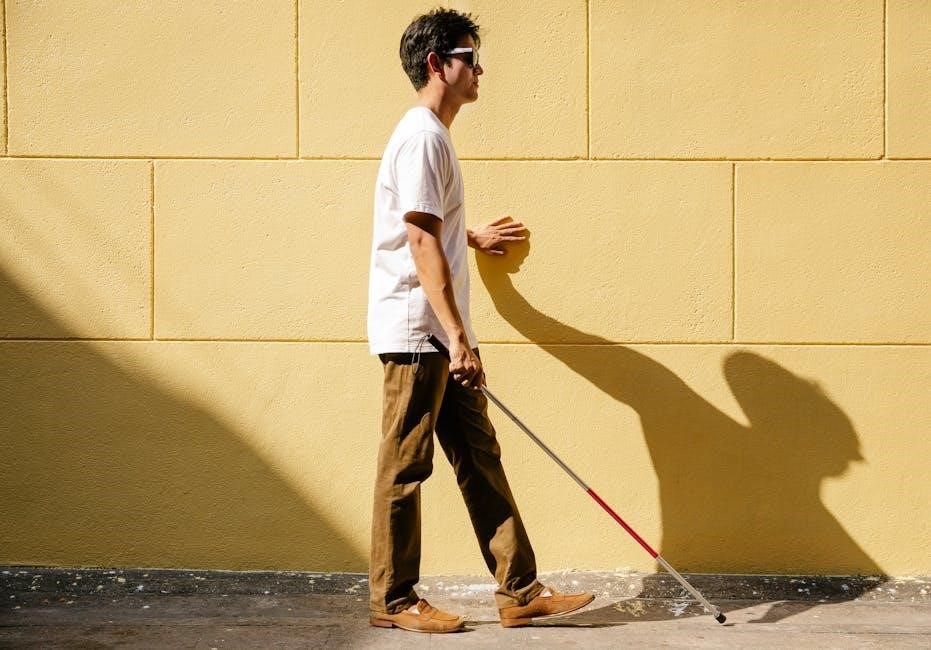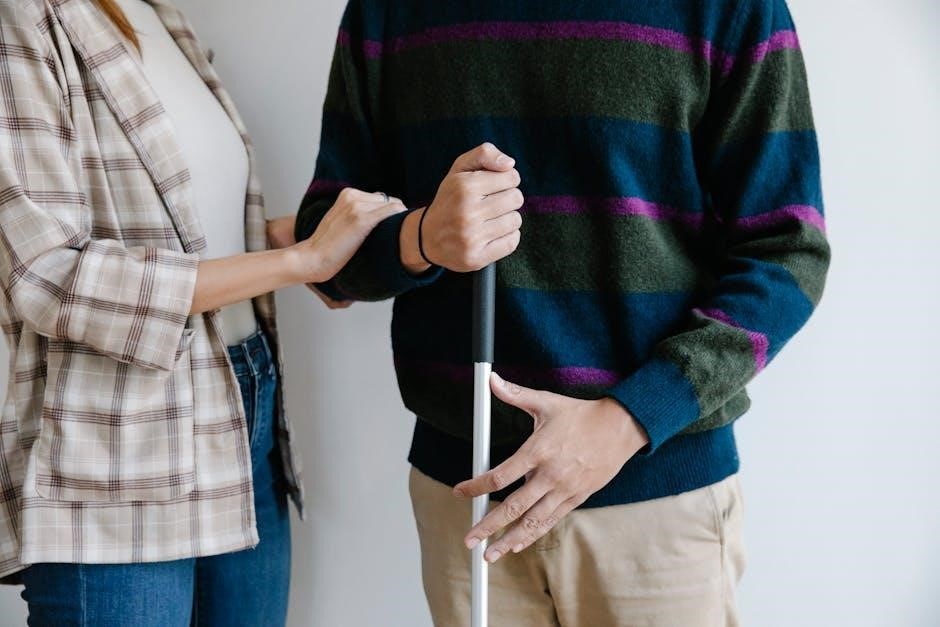guide for blind runners

Running offers blind individuals a sense of freedom and empowerment, proving that visual impairment doesn’t limit physical achievement. With proper techniques and tools, blind runners thrive.
Why Running is Accessible to Blind Individuals
Running is remarkably accessible to blind individuals due to its reliance on sensory perception beyond sight. Techniques like using hearing, touch, and assistive devices enable blind runners to navigate confidently. GPS tools, wearable technology, and guided support further enhance independence. The sport’s focus on rhythm and movement allows blind runners to connect with their environment and achieve physical and mental well-being. With proper training and resources, running becomes an inclusive and empowering activity for all.
Benefits of Running for Blind Runners
Running provides blind runners with numerous physical, emotional, and social benefits. It enhances cardiovascular health, strengthens muscles, and improves overall fitness. Blind runners often experience increased confidence and independence, as running allows them to navigate their surroundings effectively. The sport also fosters mental resilience, helping runners overcome challenges and build determination. Additionally, running connects blind individuals with supportive communities, creating opportunities for camaraderie and shared achievements. It proves that blindness is not a barrier to active, fulfilling lifestyles.
Purpose of the Guide
This guide aims to empower blind runners by providing comprehensive strategies for independent and safe running. It offers techniques for navigation, tips for using assistive devices, and advice on building mental and physical endurance. The guide also highlights the importance of community support and resources available to blind runners. By addressing both practical and emotional aspects, it helps blind individuals embrace running as a fulfilling and accessible sport, proving that visual impairment does not limit athletic potential or personal growth.

Importance of Mobility and Orientation
Mobility and orientation are essential for blind runners, enabling independence, safety, and confidence. These skills help navigate environments effectively, ensuring awareness of surroundings and obstacles.
Techniques for Navigating While Running
Blind runners use various techniques to navigate safely while running. The white cane is a primary tool for detecting obstacles and measuring distances. GPS devices provide real-time location feedback, helping runners stay on course. Tactile markers, such as raised paths or vibrations, assist in identifying landmarks. Mental mapping of routes enhances spatial awareness, while auditory cues, like traffic sounds or footsteps, help assess surroundings. These methods ensure independence and confidence, allowing blind runners to move seamlessly through their environments.
Using Hearing and Touch for Awareness
Hearing and touch are vital senses for blind runners, enhancing their spatial awareness and safety. Environmental sounds, like footfalls or traffic, help detect obstacles and navigate. The white cane is a crucial tool, providing tactile feedback about terrain and objects. Runners also use touch to sense wind direction or vibrations, aiding in orientation. By mastering these sensory inputs, blind runners build a mental map of their surroundings, ensuring confident and independent movement while running.

Safety Considerations for Blind Runners
Safety is paramount for blind runners, involving careful route selection, use of guide runners, and assistive devices like GPS and white canes to navigate obstacles effectively.
Choosing Safe Running Routes
Selecting safe running routes is crucial for blind runners. Routes should have minimal obstacles, clear pathways, and predictable terrain. Using GPS-enabled devices or screen readers helps identify hazards and navigate effectively. Running in well-known areas or parks with consistent layouts reduces risks. Avoiding busy streets and uneven surfaces is recommended. Blind runners often benefit from guides or running in groups for added safety. Evaluating routes beforehand ensures a smoother and more enjoyable experience, allowing runners to focus on their performance and mental well-being while staying safe.
Using GPS and Assistive Devices
GPS and assistive devices play a vital role in enhancing the running experience for blind individuals. Wearable devices with audio feedback provide real-time information about speed, distance, and navigation. Screen readers integrated into smartwatches or fitness trackers offer accessibility to critical data. Additionally, tactile devices, such as vibrating wristbands, can signal changes in direction or pace. These tools empower runners to maintain independence and confidence. By leveraging technology, blind runners can safely navigate routes and track their progress with precision, ensuring a more enjoyable and autonomous running experience.

Communication and Guidance
Effective communication is key for blind runners, ensuring safety and confidence. Sighted guides provide verbal cues, while assistive devices offer real-time feedback, fostering independence and teamwork.
Role of a Sighted Guide
A sighted guide plays a crucial role in enabling blind runners to navigate safely and confidently. They provide verbal cues about obstacles, inclines, and directions, ensuring the runner stays on course. Physical guidance, such as tethering with a short rope or elbow-to-hand contact, helps maintain rhythm and balance. The guide’s clear communication and descriptive feedback build trust and teamwork, allowing the runner to focus on their performance. Effective guiding requires patience, awareness, and strong communication skills to create a seamless running experience for both parties.
Effective Communication Strategies
Effective communication is vital for blind runners and their guides to ensure a safe and successful experience. Clear, concise verbal cues about obstacles, directions, and pace help the runner navigate confidently. Using consistent terminology and descriptive language aids understanding. Non-verbal signals, such as tugs on a tether, can also convey important information. Pre-run briefings to discuss the route, potential hazards, and communication methods build trust and coordination. Regular check-ins during the run ensure both parties are aligned, fostering a seamless and enjoyable running partnership.

Technology for Blind Runners
Technology empowers blind runners with wearable devices, GPS apps, and audio feedback, providing real-time navigation and safety alerts, enhancing independence and confidence during runs.
Wearable Devices and Apps
Wearable devices and specialized apps revolutionize running for the blind by providing real-time feedback and navigation. Smartwatches and fitness trackers with tactile or audio cues help monitor pace, distance, and heart rate. Apps like Runkeeper and Google Fit offer voice-guided navigation, while others, such as Seeing AI, use camera-based technology to detect obstacles. These tools empower runners to train independently, stay safe, and track progress effectively, fostering confidence and autonomy in their running journey.
Audio Feedback and Navigation Tools
Audio feedback and navigation tools are essential for blind runners, providing critical real-time information. Apps like Runkeeper and Google Fit offer voice-guided navigation, announcing pace, distance, and route directions. Specialized tools like Seeing AI and VoiceOver deliver obstacle detection and environmental feedback, enhancing safety. These technologies enable runners to navigate confidently, receive performance metrics, and stay oriented without visual cues, fostering independence and improving overall running experiences.

Training and Preparation
Training and preparation empower blind runners to build routines, strengthen endurance, and gain confidence through structured practice and mental conditioning, fostering independence and achievement.
Building a Running Routine
Establishing a consistent running routine is essential for blind runners to build confidence and endurance. Start with short distances and gradually increase over time, ensuring progress feels achievable. A well-structured routine includes warm-ups, cool-downs, and rest days to prevent injury. Tailor your schedule to suit individual needs, incorporating techniques like tactile marking or auditory cues for navigation. Safety is key, so choose familiar routes and use assistive devices. Tracking progress and celebrating milestones can motivate continued growth and enjoyment in the sport.
Strengthening Mental and Physical Endurance
Building mental and physical endurance is vital for blind runners to overcome challenges and achieve their goals. Mental resilience can be developed through visualization techniques, positive affirmations, and focusing on tactile and auditory cues. Physically, gradual training with interval runs and strength exercises enhances stamina and overall performance. Incorporating rest and recovery into the routine ensures sustainability and injury prevention. By combining these strategies, blind runners can foster a strong mind-body connection, enabling them to push boundaries and embrace the transformative power of running with confidence and determination.

Community and Support
Blind runners thrive with strong community ties, shared experiences, and mentorship. Collective encouragement and guidance empower them to stay motivated and overcome challenges, fostering resilience and achievement.
Joining Blind Running Groups
Joining blind running groups offers a sense of community and belonging, where runners share experiences and challenges. These groups foster resilience and camaraderie, providing mentorship from experienced blind runners. They create a supportive environment that motivates individuals to push their limits. The collective encouragement helps runners overcome obstacles, both physical and mental. Connecting with others who face similar challenges builds confidence and inspiration, while shared achievements celebrate progress. These groups enhance running experiences and empower individuals to achieve their full potential.
Resources for Blind Runners
Resources for blind runners include organizations like Guide Dogs for the Blind and the United States Association of Blind Athletes, which provide training and support. Adaptive technologies such as GPS-enabled smartwatches and apps like RNIB Navigator assist with navigation and tracking. Online forums and local running groups offer community support and knowledge sharing. These resources empower blind runners to train safely, connect with others, and maintain independence while pursuing their passion for running. They play a crucial role in helping runners achieve their goals and enjoy the sport fully.